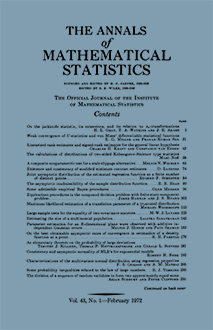Abstract
In [5], the concept of statistical sufficiency is studied within a general probability setting. The study is continued here. The notation and definitions of [5] are used. Here we give an example of sufficient statistics $t_1$ and $t_2$ such that the pair $(t_1, t_2)$ is not sufficient. The example also has the property that, in a sense to be made precise, no smallest sufficient statistic containing $t_1$ and $t_2$ exists. In Example 4 of [5], sufficient subfields $\mathbf{A}_1$ and $\mathbf{A}_2$ are exhibited such that $\mathbf{A}_1 \vee \mathbf{A}_2$, the smallest subfield containing $\mathbf{A}_1 and \mathbf{A}_2$, is not sufficient. Such an example is given here with the even stronger property that no smallest sufficient subfield containing $\mathbf{A}_1$ and $\mathbf{A}_2$ exists. Let $(X, \mathbf{A}, P)$ be the probability structure under consideration. Here $X$ is a set, $\mathbf{A}$ is a $\sigma$-field of subsets of $X$, and $P$ is a family of probability measures $p$ on $\mathbf{A}$. Let $\mathbf{N}$ be the smallest $\sigma$-field containing the $P$-null sets and let $K$ be the collection of sufficient subfields of $A$ containing $N$. (Restricting attention to sufficient subfields containing $N$ is technically convenient. Note that any sufficient subfield is equivalent, in the usual sense, to one containing $N$.) Some of the properties of $K$ can be described in the language of lattice theory as follows. Let $L$ be the set of subfields (= sub-$\sigma$-fields) of $\mathbf{A}$. Then $L$, partially ordered by inclusion, is a complete lattice. (Our terminology is essentially that of Birkhoff [4].) Example 4 of [5], mentioned above, shows that $K$ is not always a sublattice of $L$. The example given below shows more: The set $K$, partially ordered by inclusion, is not always a lattice in its own right. Note, however, that if $H$ is a finite, or even countable, subset of $K$, then the greatest lower bound of $H$ relative to $L$ exists and is in $K$ ([5], Corollary 2). The difficulty is with the least upper bound. There is less difficulty if $\mathbf{A}$ is separable. Corollaries 2 and 4 of [5] indicate that if $A$ is separable, then $K$ is a $\sigma$-complete sublattice of $L$. This is about as strong a result as could be expected here. For even if $\mathbf{A}$ is separable, $\mathbf{K}$ is sometimes neither complete nor conditionally complete: Each of the nonsufficient subfields exhibited in Example 1 of [5] is easily seen to be both the greatest lower bound of a subset of $K$ and the least upper bound of a subset of $K$. There is no difficulty if $P$ is dominated. If $P$ is dominated, then $K$ is a complete sublattice of $L$. This follows easily from the existence in this case (Bahadur [2], Theorems 6.2 and 6.4; Loeve [6], Section 24.4) of a subfield $\mathbf{A}_0$ in $K$ such that $K = \{\mathbf{B} \mid \mathbf{B} \epsilon L, \mathbf{A}_0 \subset \mathbf{B}\}$.
Citation
D. L. Burkholder. "On the Order Structure of the Set of Sufficient Subfields." Ann. Math. Statist. 33 (2) 596 - 599, June, 1962. https://doi.org/10.1214/aoms/1177704584
Information





